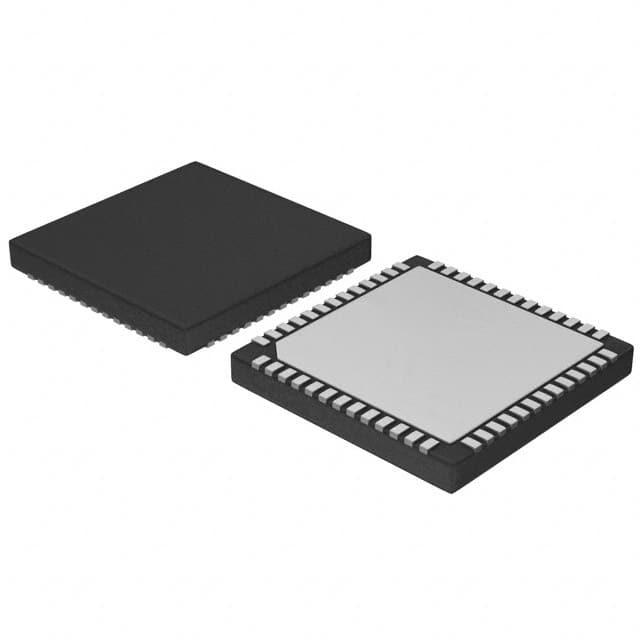Voir les spécifications pour les détails du produit.

NB7L111MMNG
Basic Information Overview
- Category: Integrated Circuit (IC)
- Use: Clock and Data Recovery (CDR) for high-speed serial data transmission
- Characteristics: Low-power, high-performance, compact size
- Package: 48-pin QFN (Quad Flat No-Lead)
- Essence: Clock and data synchronization and recovery
- Packaging/Quantity: Tape and reel, 2500 units per reel
Specifications and Parameters
- Supply Voltage: 2.375V to 3.465V
- Input Frequency Range: 1Mbps to 6.4Gbps
- Operating Temperature Range: -40°C to +85°C
- Output Type: Differential
- Output Voltage Swing: 400mV (typical)
- Power Dissipation: 500mW (typical)
Detailed and Complete Pin Configuration
- VDDA
- VSSA
- CLKIN_P
- CLKIN_N
- VREFP
- VREFN
- VDDO
- VSSO
- LOS
- CDR_EN
- REFCLK_P
- REFCLK_N
- VDDI
- VSSI
- DATA_P
- DATA_N
- VDDQ
- VSSQ
- VDD
- VSS
- NC
- NC
- NC
- NC
- NC
- NC
- NC
- NC
- NC
- NC
- NC
- NC
- NC
- NC
- NC
- NC
- NC
- NC
- NC
- NC
- NC
- NC
- NC
- NC
- NC
- NC
- NC
- NC
Functional Characteristics
- Clock and data recovery from high-speed serial data streams
- Automatic frequency and phase acquisition
- Low-jitter output clock generation
- Loss of Signal (LOS) detection
- Selectable reference clock input
Advantages and Disadvantages
Advantages: - Low power consumption - High-performance signal recovery - Compact size for space-constrained applications
Disadvantages: - Limited input frequency range - Sensitivity to noise and signal degradation
Applicable Range of Products
- High-speed data communication systems
- Fiber optic networks
- Telecommunication equipment
- Data centers
- Networking devices
Working Principles
The NB7L111MMNG is a Clock and Data Recovery (CDR) IC designed to recover clock and data signals from high-speed serial data streams. It utilizes advanced algorithms to automatically acquire the frequency and phase of the incoming data, ensuring accurate synchronization. The recovered clock signal can be used for timing purposes, while the recovered data can be further processed or transmitted.
Detailed Application Field Plans
- High-speed data transmission in telecommunications: The NB7L111MMNG can be used in optical communication systems to recover clock and data signals from fiber optic links, enabling reliable and efficient data transmission.
- Networking equipment: The IC can be integrated into networking devices such as routers and switches to recover clock and data signals from high-speed Ethernet connections, ensuring accurate data transfer.
- Data centers: The NB7L111MMNG can be utilized in data centers to recover clock and data signals from high-speed interconnects, facilitating seamless data transfer between servers and storage systems.
- Test and measurement instruments: The IC can be employed in test and measurement equipment to recover clock and data signals from high-speed digital interfaces, enabling accurate analysis and characterization of the tested signals.
- Broadcast and video production: The NB7L111MMNG can be used in broadcast and video production systems to recover clock and data signals from high-speed video interfaces, ensuring precise synchronization and reliable signal transmission.
Detailed Alternative Models
- NB7L111S: Similar functionality with a different pin configuration.
- NB7L111M: Higher operating temperature range (-40°C to +105°C).
- NB7L111L: Lower power consumption with reduced performance specifications.
- NB7L111H: Higher input frequency range (up to 12.5Gbps) for more demanding applications.
- NB7L111P: Enhanced ESD protection for improved reliability in harsh environments.
5 Common Technical Questions and Answers
Q: What is the maximum input frequency supported by the NB7L111MMNG? A: The IC supports an input frequency range of 1Mbps to 6.4Gbps.
Q: Can the NB7L111MMNG operate in extreme temperature conditions? A: The IC is designed to operate within

